The previous blog talked about rail shooting games and talked slightly about their evolution. As technology advanced so did the gaming experience. Thanks to new processors and more powerful software games moved from pixels onto polygons. Thanks to advances in hardware arcade machines were changed from stationary to immersive experiences with moving seats, force feedback controls and surround sound. At home the rail shooter was experiencing a shift as well. There was a quantum leap in graphics technologies from the previous polygon attempts featured in Silpheed and Star Fox to the new 32-bit generation. Many could pinpoint the start of the era to 1995 with the release of Panzer Dragoon on the Sega Saturn.
The game was still set on rails, yet like Star Fox players could fly around on the screen, while tracking and shooting down opponents. The game was visually stunning. The new consoles were able to render polygons with textures, transparencies and a myriad of colors. The designers at Team Andromeda created some fantastic designs including flying creatures, floating battleships and citadels that defied gravity and were able to present them convincingly in game form. They took full advantage of the 32-bit processing power and expanded memory available to them. While Panzer Dragoon was not the commercial success of Star Fox it did herald the arrival of the arcade quality rail shooter to home consoles.

Panzer Dragoon Saga was a hybrid title combining the rail shooting mechanics with a role-playing experience. Players could upgrade the stats and abilities of their dragon after major boss battles. These changes affected the physical appearance, including the color and armored scales of the dragon as much as the way it handled in far more dimensions than was possible in Zwei. Players could make their dragon defensive with lots of heavy armor and stubby wings, or speedy with long skinny wings and physical features. They could also blend in the changes that came along with having an attack or magic based dragon. Of course there could be a blend of all four types to have a well rounded dragon that looked unique as well.

By the year 2000 the rail shooter seemed to have run out of steam. The indy game and mobile gaming were beginning to wean players away from arcades and the rail shooter genre.
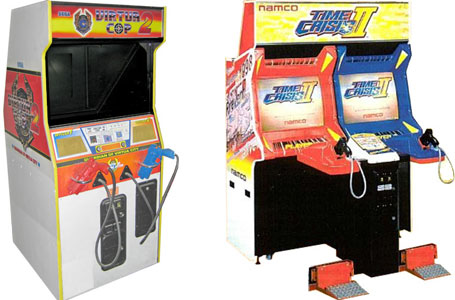
The light gun mechanics used in some rail shooters made the transition to consoles very well. Gunblade NY and its sequel LA Machine Guns (released in 1998) was ported over for the Wii. Part of the arcade experience was lost as handling the Wiimote would be much easier than swinging around the hefty machine guns. It was good to see the rail shooters get a new lease on life. Games that started out in the arcade, like House of the Dead from 1996, found their way onto consoles as well. An arcade style console exclusive sequel titled House of the Dead Overkill was released on the Wii in 2009 and the PS3 in 2011.
The rail mechanics were a stark contrast to the wide-open survival horror FPS title Left 4 Dead. The scenarios, levels and designs were similar but the gameplay was different. Some players enjoyed the freedom than came with exploring the world in Left 4 Dead while others enjoyed the quick point and shoot mechanics with a tangible gun controller in hand.
After years of honing the rail shooter on consoles and arcade cabinets Sega married those technologies with amusement park attractions. In 1997 Sega built a roller coaster titled Rail Chase, themed after the videogame. The ride appeared at their Joypolis location in Tokyo Japan and at Sega World, the Sydney version of Joypolis. At the time it was Sydney’s only indoor roller coaster. Players went through a series of scenarios which were inspired by the locations featured in the game, including snowy peaks, dark caves and desert valleys. Best of all the riders could shoot at targets with light guns and interact with the scenery.

Sega also married the dark ride with arcade technology. The attraction Ghost Hunters was not based on any particular arcade game, although one of their earliest rail shooters released in 1990 was titled Laser Ghost. In that game players took on the role of ghost fighters, shooting at ghosts with laser firing machine guns. The title, like many early Sega arcade games was based heavily on Western pop culture. Shinobi for example had unlicensed cameos of Spider-Man, Batman, the Terminator and Godzilla.

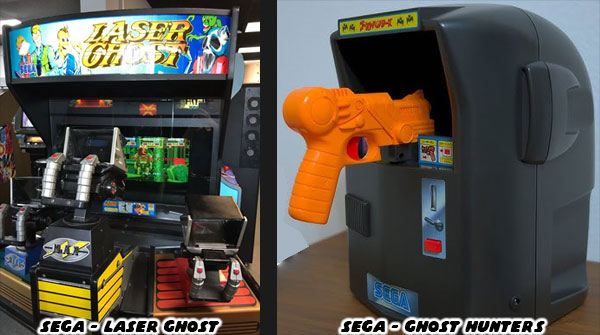
Ghost Hunters was a sit down ride that went through a dark maze. On the walls were mirrors and projections with holograms, black light paintings and polygon-generated spirits. Players could use the plastic cannons mounted in front of their seats to shoot projected beams of energy at the ghosts on the screens. The effect was somewhere between an electrical arc and the wavy beams from the Ghostbuster’s Proton Packs.
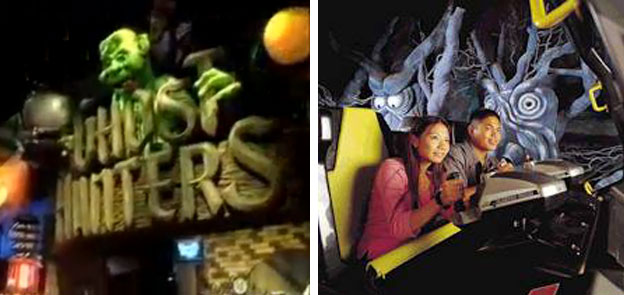
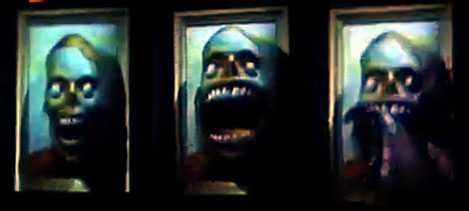
The rides at Joypolis and Sega World paved the road of interactive attractions at theme parks. One of the adopters of the format would be the biggest name in the industry. Disney merged the dark ride, animatronics and the interactive light gun experience in 2004 through Buzz Lightyear's Astro Blasters. In that attraction audiences got to play the part of a Space Ranger taking on Zurg. Guests were able to shoot at targets and score points using a light gun as they traveled through a series of rooms. Scores were tracked by the ride itself. What made the attraction unique was that the rooms were painted in fluorescent paint which had a soft glow under the black light. Plus all throughout the ride there were giant models, moving props and a couple of large animatronic figures. Everything in the ride was a tangible object.

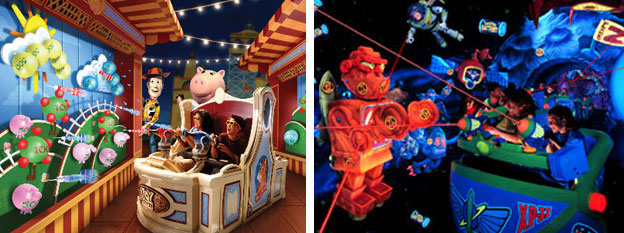
By using LCD screens instead of building physical animatronics Disney would be able to go back into the attraction and add new games and characters whenever they wanted. Such was the case when Toy Story 3 was released. The Disney Imagineers were able to incorporate the characters introduced in the film within a year of its release. Visitors to the park were amazed at the fast turnaround that the game technology provided.
The end of the 90’s and start of the 2K era saw a global decline in arcade sales and a shift to console and mobile gaming. Long time market rivals Sega and Namco even partnered up in 2000 to release a rail shooter Vampire Night on the PS2. The shift away from the arcade combined with poor business planning hurt many companies. Many publishers were forced to merge to stay afloat or become profitable again. SNK merged with Playmore, Sega and Sammy partnered up and Bandai merged with Namco. These changes in the companies did not mean that they stopped innovating in the arcade. They simply had to be more practical with their titles.
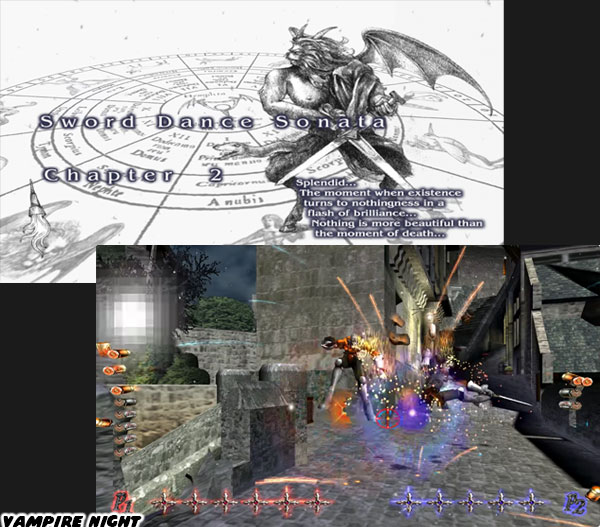
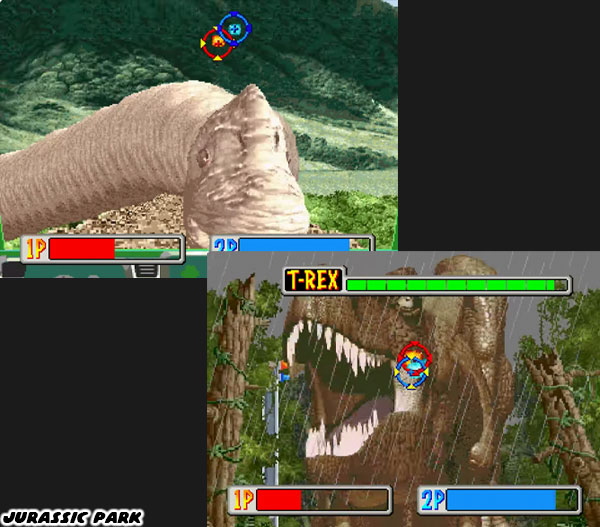
The game was well received by audiences. It presented some amazing battles and scenarios using a great rendering engine. Like Let’s Go Jungle! this game was one of the early rail shooters in the arcade to be presented on a high definition display. The themes featured in the game were very rich, combining classic Western pirate designs with a hint of anime and other Japanese aesthetics. It did not hurt that the game came on the heels of the Pirates of the Caribbean trilogy. As Sega had found success taking cues from pop culture in the 80’s and 90’s Namco was now doing by poaching many of the ideas from the PotC films and attractions. The game did so well in the arcade that Namco updated the technology for new builds and offered a stereoscopic (glasses free) 3D version of the game and a motion-based 4D version. The game eventually found its way onto the Playstation 3.
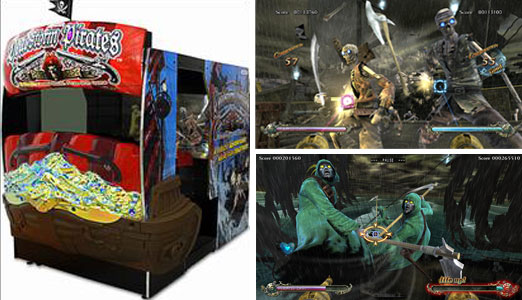
Not to be outdone Sega had stepped up the development of the Let’s Go series by releasing a glasses free 3D version of the sequel, Let’s Go Island in 2011.
The deluxe versions of the games incorporated the motion seat technology and encapsulating themed cabinets, going so far as blasting players with air as Disney had done in Midway Mania. The mix of the classic arcade and amusement park designs was a step at bringing Sega back to the elements that made their earlier rail shooters memorable.

Where the rail shooter goes from here is only limited by the imagination of designers and of course the budget allotted to them by the publishers. In this regard Disney is in a favorable position over game developers. Disney has a built in audience visiting the parks and usually a tremendous budget to satisfy expectations. Interactive attractions at their parks are built to reward visitors at every skill level, not just the gamers. Unlike arcade games the theme park experience does not end if the player fails to score enough points.
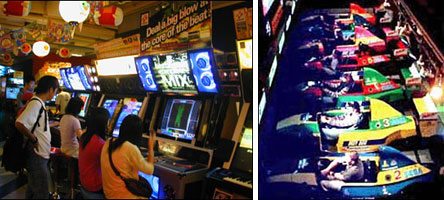
Theme parks do not charge visitors for every ride they get on nor do the interactive experiences ever change in difficulty. The visitors themselves choose how hard they are willing to play while the park makes a profit elsewhere, like in food and merchandising. Visitors to theme parks do not expect to get kicked out of an interactive ride for playing poorly, so each ride through Astro Blaster or Midway Mania is guaranteed to come to a conclusion. There are no guarantees that gamers in the arcade will ever see the final screen. However to their credit the games in the arcade usually last much longer than any dark ride, some games could go for 45 minutes or more, the Pirates of the Caribbean attraction lasts around 16 minutes by comparison.
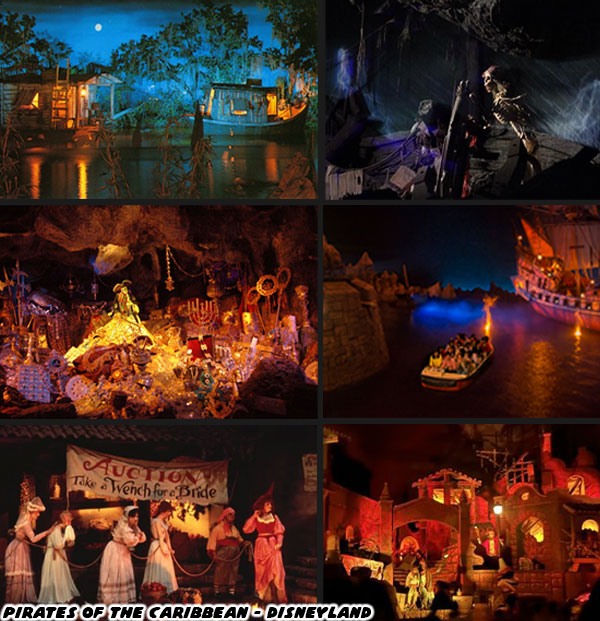
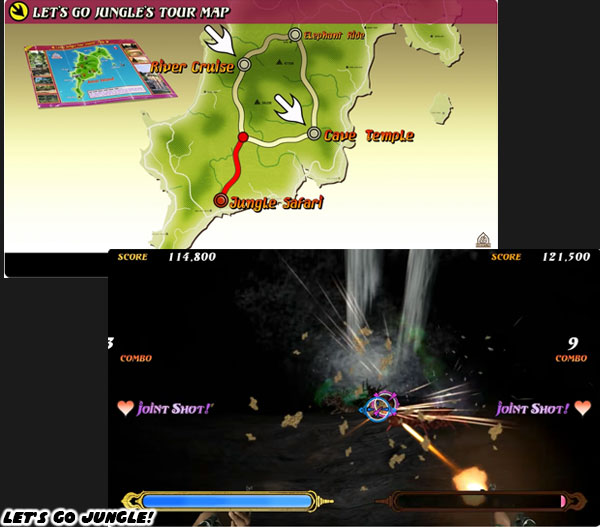
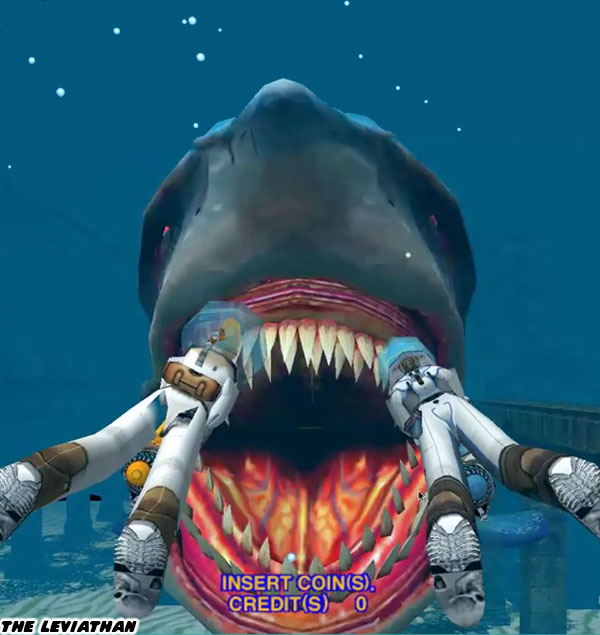

No comments:
Post a Comment